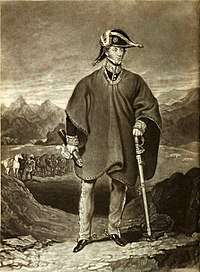Guillermo Miller
William Miller (2 December 1795 – 31 October 1861) known throughout Latin America as Guillermo Miller, was an English-born soldier who participated in several South American revolutions, and then became a diplomat.
Guillermo Miller | |
|---|---|
 Miller, in the uniform of the general of the army of Peru, during the Ayacucho campaign | |
| Native name | William Miller |
| Born | 2 December 1795 Wingham, England |
| Died | 31 October 1861 Lima, Peru |
| Allegiance | |
| Battles/wars | Peninsular War
War of 1812
|
Biography
Born December 2, 1795 in Wingham, Kent, Miller was fluent in several languages by the age of seventeen, when he enrolled in the British army to fight in the Napoleonic Wars,[1] taking part in the Siege of Badajoz and Battle of Vittoria under the Duke of Wellington. In September 1817, hearing of the wars in Latin America, he set sail for Buenos Aires to join San Martín's Army of the Andes.[2] He took part in San Martín's liberation of Chile, participating in the decisive battle of Maipú, and then joined Lord Cochrane as the commander of marines in the Chilean Navy. He participated in the failed expedition to Chiloé and lost the little but significant Battle of Agüi.
Peru
After the liberation of Lima, Peru he was appointed commander of the Peruvian Legion. General Miller - while suffering from malaria - played a big part in the Battle of Tarata: storming the hills and taking them when everything seemed to be lost. Peru President José de la Riva Agüero promoted Miller to General of Brigade and, when Simón Bolívar arrived, he was promoted to Chief of a cavalry unit that included Argentines and Chileans who had arrived with San Martín, in addition to many Peruvians and Colombians.
At the Battle of Junín his cavalry was largely responsible for the defeat of the Spanish and at the Battle of Ayacucho his initiative in launching an attack at a critical moment, without waiting for Sucre's orders, was decisive in securing victory. During these wars Miller was wounded twenty two times, and after his death the autopsy revealed he had carried two bullets in his liver for 40 years.
He created the Hussars of the Peruvian Legion who, after turning the course of the Battle of Junín in favour of the revolutionaries, were renamed the "Hussars of Junín". These same Hussars remain in charge of the guard at the Peruvian Palace of Government in Lima.
After the war was over, Miller settled in Lima. He held various public offices, but argued with the governments after 1836, mainly about their treatment of the Indians. As a result, he was stripped of his rank as Grand Marshal of Peru. His brother John wrote a two-volume biography in 1828.[3][4]
Hawaii
_(retouched).jpg)
Miller became British diplomatic Consul to Pacific islands such as the Kingdom of Hawaii in 1843 after Richard Charlton. He arrived in Honolulu in January 1844 with his Scottish friend Robert Crichton Wyllie. Wyllie acted as assistant in Hawaii while Miller traveled to the rest of the Pacific islands from July 1844 to March 15, 1845. Wyllie would then become Minister of Foreign Affairs for the Kingdom of Hawaii.[5]
In 1859 Busvargus Toup Nicolas (1819–1859), son of Admiral John Toup Nicolas (1788–1851), temporarily replaced Miller as consul.[6]
Return to Peru
On Nicolas' return because of ill health, English merchant William Lowthian Green acted as consul until William W. F. Synge (1826–1891), could finally be sent as a permanent official replacement. Miller died in Callao October 31, 1861, aged 65, and was initially buried in the Old British Cemetery, Bellavista. In the 1920s, his body was transferred to the Panteon de los Proceres, the final resting place for the heroes of the War of Independence.
There is a house in Markham College named after him.
References
| Wikimedia Commons has media related to William Miller (Peruvian general). |
- Frederic Boase (1897). Modern English biography: containing many thousand concise memoirs of persons who have died since the year 1850, with an index of the most interesting matter. 2. Netherton and Worth. p. 1906.
- Anthony McFarlane (2013). War and Independence in Spanish America. 1. New York: Routledge. p. 362. ISBN 9781136757723.
- John Miller (1828). Memoirs of General Miller: in the service of the republic of Peru. Volume 1. Longman, Rees, Orme, Brown, and Green.
- John Miller (1829). Memoirs of General Miller: in the service of the republic of Peru. Volume 2. Longman, Rees, Orme, Brown, and Green.
- Ralph Simpson Kuykendall (1965) [1938]. Hawaiian Kingdom 1778-1854, foundation and transformation. 1. University of Hawaii Press. p. 234. ISBN 0-87022-431-X.
- George Clement Boase; William Prideaux Courtney (1874). Bibliotheca cornubiensis: A catalogue of the writings, both manuscript and printed, of Cornishmen, and of works relating to the county of Cornwall, with biographical memoranda and copious literary references. Longmans, Green, Reader and Dyer. p. 390.
| Diplomatic posts | ||
|---|---|---|
| Preceded by Richard Charlton |
U.K. Consul to Kingdom of Hawaii 1844–1859 |
Succeeded by William W. F. Synge |